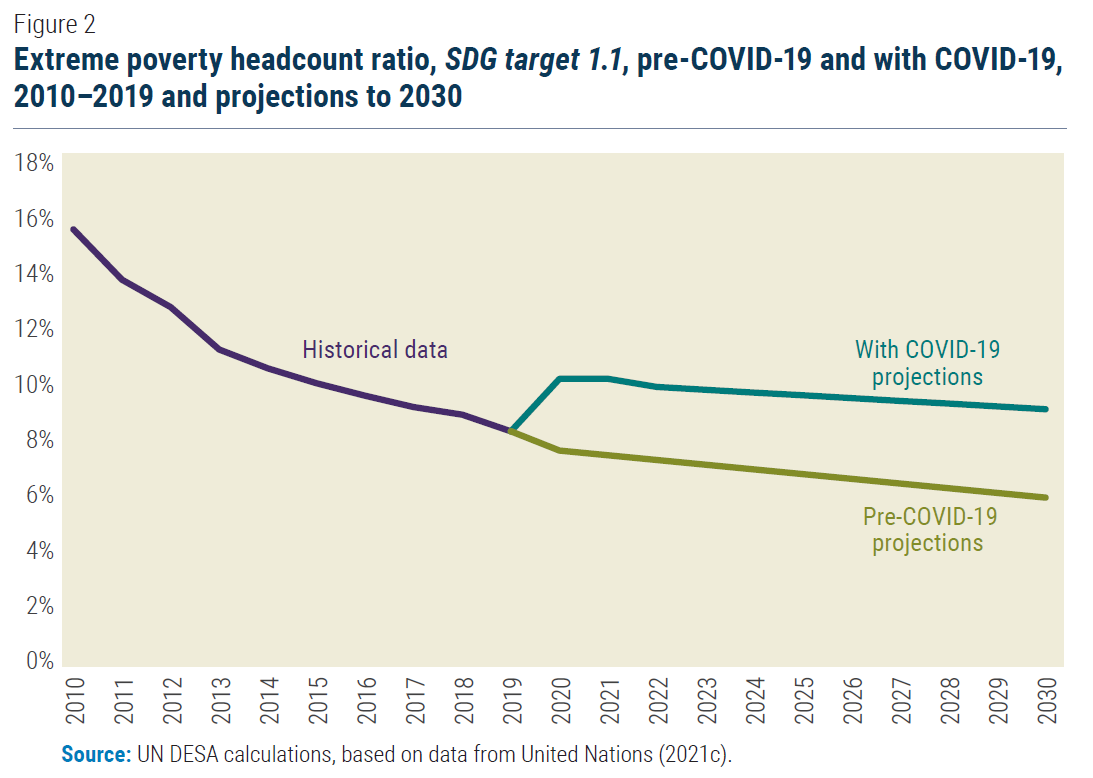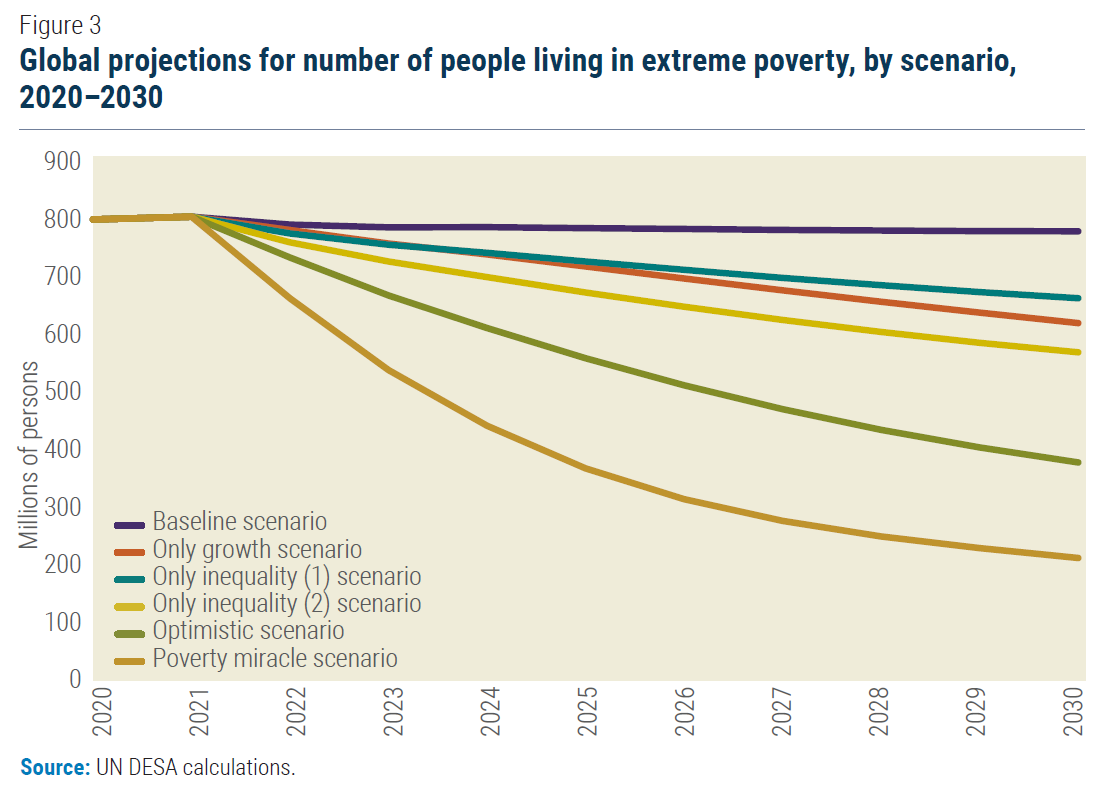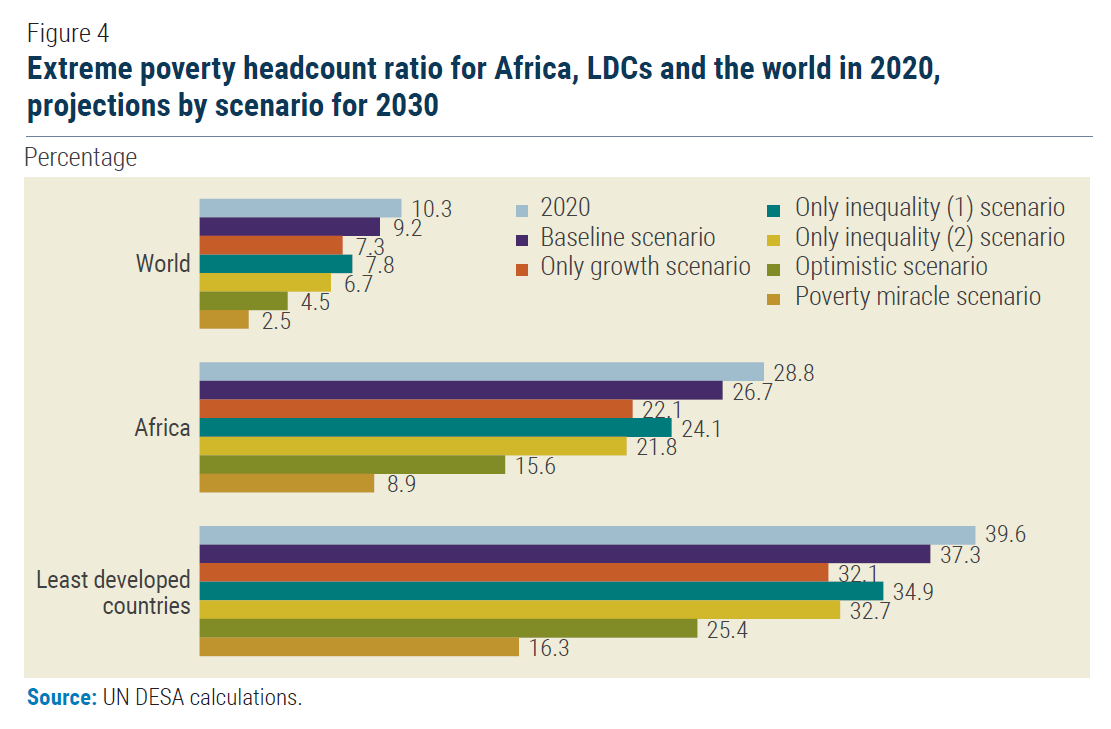
UN/DESA Policy Brief #119: The critical role of income redistribution for poverty reduction: Alternative scenarios
The link between economic growth and poverty reduction is not linear. The way in which additional income is distributed matters for poverty outcomes. The same economic growth rate can cause different levels of poverty reduction in countries with different levels of inequality. Evidence also shows that countries with a more equal distribution of assets and income often grow faster than those with a higher degree of inequality. There may thus exist a virtuous cycle between growth and equity. This policy brief will present modelling evidence which demonstrate the importance of addressing income inequality as a key strategy to accelerate the progress on SDG 1 (eradicating poverty).
Pre-pandemic progress towards achieving SDG 1
Considerable progress towards SDG 1 was achieved during pre-COVID-19 years. According to the Sustainable Development Goals Report 2021 (United Nations, 2021a), the share of the world’s population living in extreme poverty (SDG target 1.1) declined from 15.7 per cent in 2010 to 8.4 per cent in 2019. The Report also notes that the share of the world’s workers living in extreme poverty fell from 14 per cent in 2010 to 7.8 per cent in 2015 and again to 6.6 per cent in 2019, although the pace of progress slowed after 2013. The share of young workers living in extreme poverty globally also declined, from 19.8 per cent in 2010 to 12.8 per cent in 2019.
Progress on other SDG 1 targets was slower. In 2020, some 4 billion people, or 53 per cent of the world’s population, did not benefit from any form of social protection (SDG target 1.3). This percentage was 85.4 per cent in high-income countries prior to the COVID-19 pandemic, but only 13.4 per cent in low-income countries. For those considered vulnerable in low-income countries, the percentage was even lower, or at 7.8 per cent. As of February 2020, 87 countries had unemployment programmes anchored in national legislation, with only 34 of those countries covering the self-employed. The coverage of unemployment protection varied widely across regions. While in Australia and New Zealand, half of unemployed people receive unemployment benefits, and 44 per cent in Europe and North America, only 3 and 12 per cent of people in sub-Saharan Africa and Latin America and the Caribbean receive such payments, respectively. One of the main determinants of countries’ success in dealing with the COVID-19 pandemic was the existence of such social protection systems (Islam et al., 2020). Without income protection it was difficult for people to comply with lockdown measures. Adequate social protection is thus a pre-condition for effectively dealing with pandemics like COVID-19.

The Eastern, South-Eastern, and South Asia subregions have been the driving force behind the progress in eradicating extreme poverty in the past decade (figure 1). Poverty declined in sub-Saharan Africa too, although remaining at a high level. In Latin America and the Caribbean, on the other hand, progress in eradicating extreme poverty stagnated in the last few years before the pandemic. In Northern Africa and Western Asia, extreme poverty actually increased in the last few years before COVID-19.
Outlook for the extreme poverty headcount by 2030
Baseline scenario
Prior to COVID-19, UN DESA had projected that the extreme poverty headcount would reach 7.7 per cent in 2020 and 6.0 per cent in 2030, short of reaching the global target of ending poverty. The pandemic led to significant economic contraction and increased unemployment in both developing and developed countries, resulting in the worst economic situation the world has faced in 90 years.
This economic contraction has severely impacted the global progress on SDG target 1.1, pushing somewhere between 119 million and 124 million additional people into extreme poverty, of whom 60 per cent are in Southern Asia (United Nations, 2021b). Of particular note is that eight out of ten “new poor” reside in middle-income countries. The economic crisis caused by the COVID-19 pandemic also has had a disproportionate impact on the livelihoods of young and female workers, who are already much more likely to be living in poverty. In 2019, young people were twice as likely as adults to be among the working poor. A substantial gender gap also exist in many parts of the world, particularly in the least developed countries where 33.5 per cent of women were living in poverty in 2019 compared to 28.3 per cent of men.
 According to projections reflecting the impact of the COVID-19 pandemic and presented in the mid-year update of the World Economic Situation and Prospects 2021, the global poverty rate in 2020 could jump to 10.3 per cent and decline to only 9.2 per cent by 2030 (figure 2). This would mean that as many as 785 million people could find themselves in extreme poverty by 2030 (United Nations, 2021c).
According to projections reflecting the impact of the COVID-19 pandemic and presented in the mid-year update of the World Economic Situation and Prospects 2021, the global poverty rate in 2020 could jump to 10.3 per cent and decline to only 9.2 per cent by 2030 (figure 2). This would mean that as many as 785 million people could find themselves in extreme poverty by 2030 (United Nations, 2021c).
The above baseline scenario, based on pre- COVID-19 trends, falls short of the aim of eradicating extreme poverty by 2030. It is necessary to strive for better outcomes regarding SDG target 1.1. This will require sustained growth (SDG 8) and more equitable distribution of income (SDG 10). Progress on SDG 1 will also require countries to foster strong interlinkages with other SDGs. For example, good health and well-being (SDG 3) and quality education (SDG 4) directly impact poverty reduction by increasing the productivity of workers, strengthening the resilience of poor households, and reducing the burden of health care costs.
Alternative scenarios
 This section presents alternative scenarios that show how different combinations of economic growth and reduction in income inequality can help the world reach or get closer to achieving SDG target 1.1 by 2030. These scenarios are constructed using the World Economic Forecasting Model of the Global Economic Monitoring Branch of UN DESA, which produces forecasts under alternative assumptions regarding both the rate of per capita GDP growth and reduction in income inequality. Altogether, six possible scenarios to 2030 are constructed based on different assumptions (table 1), and the outcomes of this exercise are presented in figures 3 and 4.
This section presents alternative scenarios that show how different combinations of economic growth and reduction in income inequality can help the world reach or get closer to achieving SDG target 1.1 by 2030. These scenarios are constructed using the World Economic Forecasting Model of the Global Economic Monitoring Branch of UN DESA, which produces forecasts under alternative assumptions regarding both the rate of per capita GDP growth and reduction in income inequality. Altogether, six possible scenarios to 2030 are constructed based on different assumptions (table 1), and the outcomes of this exercise are presented in figures 3 and 4.
The baseline scenario assumes continuation of the most recent UN DESA forecast of 4.7 per cent average annual growth in GDP per capita in developing countries from 2022 to 2030 (see United Nations, 2021c), with no change in income inequality. In this scenario, about 9.2 per cent of the world’s population—or 785 million people—would remain in extreme poverty (SDG target 1.1) by 2030 (figures 3 and 4).
The only growth scenario assumes an increase in the average annual growth in GDP per capita in developing countries to 6.7 per cent in the remaining SDG period (2022– 2030), with income inequality remaining unchanged. In this scenario, the share of the world population living in extreme poverty by 2030 would decline to about 7.3 per cent, or 625 million people. The two only inequality scenarios demonstrate the impact of inequality reduction on the eradication of extreme poverty, while keeping the baseline average annual GDP per capita growth rate in developing countries the same, at 4.7 per cent. Under the modest inequality reduction of 1 per cent per annum on average, the extreme poverty rate would decline to 7.8 per cent by 2030, translating into 668 million people in poverty, a reduction of more than 100 million people from the baseline scenario. With moderate inequality reduction (2 per cent annually on average), extreme poverty can be reduced to 575 million people by 2030.

The optimistic scenario is based on the increased economic growth rate of 6.7 per cent per annum on average in developing countries and an annual reduction of inequality by 3.1 per cent. Under this scenario, the extreme poverty rate would decline to 4.5 per cent, meaning 383 million people living in poverty, with the rate 15 and 25 per cent in Africa and the LDCs, respectively (figure 4). Finally, if the average annual per capita GDP growth rate can be raised to 10.7 per cent and income inequality reduced by 7.4 per cent per annum, the poverty rate would be reduced to 2.5 per cent by 2030, or below the “frictional” rate of 3 per cent, implying that only 217 million people will be living in extreme poverty. Given the very ambitious assumption that this scenario relies on, it has been called the poverty miracle scenario. While unrealistic for the developing world as a whole, there are historical precedents of countries achieving 10 per cent annual average growth in GDP per capita over an extended period, but not a simultaneous 7 per cent annual reduction in income inequality. Hence, achieving the poverty miracle scenario would require unprecedented political commitment for income redistribution at the national and global levels.
In sum, the above scenario analysis shows that inequality reduction can be a potent driver of poverty reduction, and, combined with robust growth, can produce positive, if not miraculous, results. At the same time, this future growth will also need to be environmentally sustainable, which will require improved management of water and other natural resources, together with movement towards low-carbon technologies, as emphasized in Sustainable Development Outlook 2021: From anguish to determination (UN DESA, 2021b).
Policy implications
Achieving SDG 1, especially in the aftermath of the COVID-19 pandemic, will require extraordinary efforts by countries, both individually and collectively. The most successful countries in terms of poverty reduction have generally been those that have followed a strategy that is sometimes referred to as “economic growth with equity,” in which the eradication of poverty is anchored in both strong economic growth and income redistribution. Such a strategy places high priority on the creation of jobs, as well as progressive taxation and more comprehensive public service provision. In countries where agriculture accounts for a large share of employment and livelihoods, especially for the poor, raising the productivity of the farming sector holds the key for successful poverty reduction in the short– and medium-term. However, higher agricultural productivity does not automatically translate into the expansion of the rural non-farm sector, and it is thus important to put in place policies that encourage smallholder farmers and rural households to increase their nonfarm income. Agricultural extension services for example can play a strategic role in fostering the growth of non-farm sectors in rural areas (UN DESA, 2021a). As the globalization and technological changes have opened up different routes to structural economic transformation, it will be necessary for countries to choose the path that fits their specific context and pays attention to equitable distribution and protection of environment (Islam and Iversen, 2018).
Further strengthening of social protection systems and increased investment in people’s capabilities and resilience will be particularly important in reducing poverty. The establishment of robust social protection and universal health-care systems should not be goals for the distant future. The focus could be on accelerating efforts to achieve universal, nationally appropriate social protection floors; making social protection systems shock-proof and utilizing efficiently the new digital technologies to overcome resource constraints. Gender mainstreaming should also be the norm for all aspects of the post-pandemic recovery efforts. The reduction of the gender digital divide should be accorded high priority.
Providing equal access of all children to quality education is critical to reversing the cycle of poverty. As economies develop, there is need to invest more in higher education and lifelong learning in order to better translate foundational knowledge and skills into those relevant to the labour market. Furthermore, making quality education available to all is critically important to national efforts to eradicate poverty, which implies that the convergence in school quality within countries should be a major component of national human capital development strategies. Improvements in education and internet access, two important enabling factors for women to reach their full potential, are also associated with significant gains in income equality (United Nations, 2021d). The eradication of poverty by 2030 will also require countries to foster systematic interlinkages with other Goals of the 2030 Agenda, as highlighted earlier. For example, the provision of basic needs such as good health (SDG 3) and safe water and sanitation (SDG 6) are critical to enable people to rise out of poverty and achieve higher income and productivity.
The mobilization of support for policy measures aimed at strengthening the redistribution of income and assets in society has never been easy. Opposition by powerful groups has often made the pursuit of income redistribution highly challenging (UN DESA, 2020). However, the massive efforts made over a short period of time during the pandemic in terms of strengthening social protection and education reminds us that change is possible. Countries should seize this opportunity to be more ambitious, to expand social protection, reimagine education and health systems, and consider solutions previously considered too difficult to implement, as argued in Sustainable Development Outlook 2021 (UN DESA, 2021b).


Follow Us